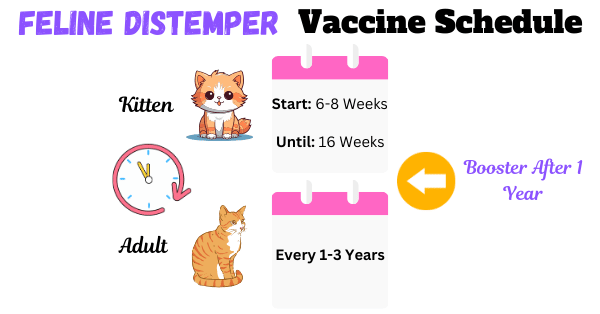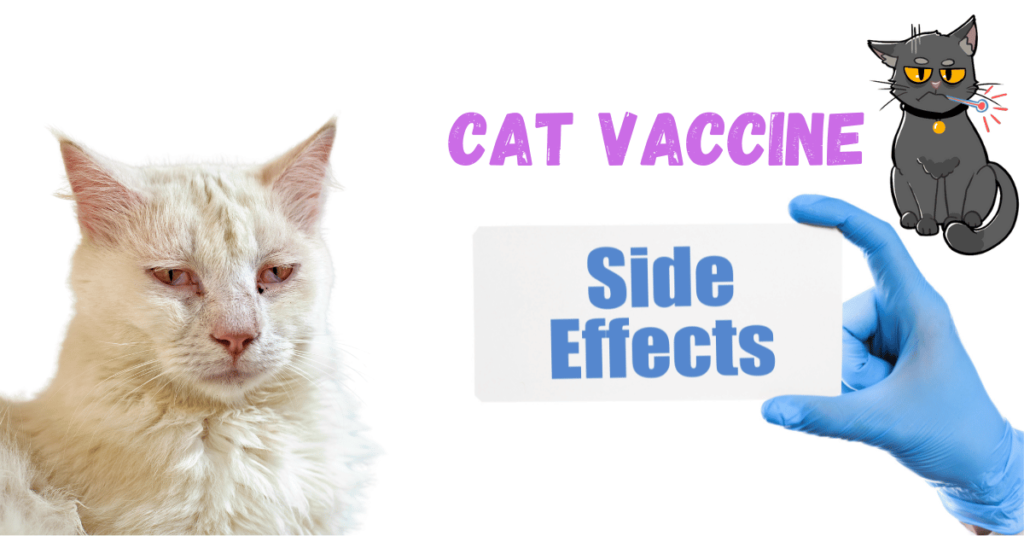This post contains affiliate links and I will be compensated if you make a purchase after clicking on my links.
Unveiling the Distemper Vaccine for Cats: Beyond the Basics
Feline Panleukopenia, often dubbed as feline distemper, is a bit of a misnomer that sticks because it’s catchy. But don’t let the name fool you—this isn’t the canine distemper you might have heard of. This tough virus, known scientifically as feline parvovirus, packs a punch, and it’s responsible for a highly contagious viral disease among cats.
The distemper vaccine for cats is actually a superhero team-up in a syringe: a combination vaccine that fights not just one, but three villains—feline viral rhinotracheitis, calicivirus, and panleukopenia. This 3-in-1 vaccine is a cornerstone of feline health, providing a shield against some of the most common and severe infectious diseases cats face.
Although the distemper vaccine for cats is a 3-in-1 combination, this post will specifically focus on feline distemper, also known as Feline Panleukopenia.

Understanding Feline Panleukopenia
Feline Panleukopenia, is not just a concern for our domesticated feline friends but also affects a range of other animals, including raccoons, ferrets, and minks. This virus is particularly insidious as it can spread in multiple ways.
Cats can contract the virus through direct contact with infected blood, urine, stool, nasal secretions, or even the fleas that have fed on an infected animal. However, direct contact isn’t the only mode of transmission—indirect contact can be just as perilous. The virus can lurk on bedding, cages, food dishes, and even on the hands or clothing of people who handle an infected cat, making it a formidable challenge to control.
Fact: Young kittens, sick cats, and unvaccinated individuals are at the highest risk.
Why Vaccinate?
Cats often hide symptoms of illness, making diseases like Feline Panleukopenia particularly dangerous. This fast-moving virus targets cells in the bone marrow and intestines, compromising the cat’s ability to defend itself and absorb nutrients. Although the outlook can be grim, timely vaccinations can prevent this severe scenario.

Kittens Under Eight Weeks
These little ones face a grim outlook if they contract Feline Panleukopenia. Their underdeveloped immune systems mean lower survival rates, and without timely intervention, their chances are slim.
Older Cats
More mature cats have a fighting chance against this harsh virus with prompt supportive care, which may include medications and fluids to boost their health while their immune defenses catch up. Still, without such care, up to 90% might not make it.
Pregnant Cats
The risks escalate for pregnant cats infected with the virus. They might not show severe symptoms but can transmit the virus to their fetuses, potentially leading to heartbreaking outcomes like abortion or severe brain damage in newborns.
Additionally, infected kittens could suffer from cerebellar hypoplasia, resulting in lifelong challenges with motor functions and overall quality of life.
The Silver Lining: Post-Recovery Immunity
However, there’s a silver lining for cats that survive an encounter with Feline Panleukopenia. These survivors develop a robust immunity that generally protects them for the remainder of their lives. Even mild, unnoticed cases can confer immunity, shielding them from future infections.
Additionally, newborn kittens may receive temporary immunity passed through the colostrum—the first milk from their mothers. This passive immunity, however, is short-lived, typically fading within 12 weeks, which underscores the critical need for vaccinations to begin early and continue as scheduled.
Tip: While there’s no cure for Feline Panleukopenia, the vaccine offers powerful prevention. It’s crucial to vaccinate your cat before exposure, as the vaccine can’t treat or cure the disease once contracted. This makes timely vaccination a key defense in protecting your feline friend.
A Deep Dive into How Cat Vaccines Work
Understanding how vaccines work can be as fascinating as watching a cat expertly navigate the top shelf without knocking off a single photo frame. Vaccines cleverly use the body’s own defense mechanisms to build protection without causing the disease. Here’s how:
Immune Memory

When your cat receives the distemper vaccine, it’s like their immune system gets a sneak peek at the enemy. The vaccine introduces a safe form of the viruses (killed or weakened) into the body, enough to stir up the immune system but not enough to cause the full-blown disease.
Like a well-trained spy, the immune system uses this encounter to learn about the invader. It develops antibodies and “memory cells” that will remember this specific virus. If the real deal ever dares to show up, these memory cells will recognize it instantly and deploy antibodies much faster and more effectively than the first time, significantly lessening its severity.
Cat Distemper Vaccine Schedule: Key Timelines
Knowing when to vaccinate your cat is crucial for ensuring they’re protected right from their early kitten days into their majestic adult years.

Kitten to Cat
The vaccination journey begins when your kitten is about six to eight weeks old. At this tender age, they receive their first shot of the distemper vaccine. This initial dose is just the beginning of a series that builds a robust defense system. Follow-up vaccines are administered every 3-4 weeks until the kitten reaches around 16 weeks of age.
Each dose further reinforces the immune system’s memory, ensuring that it’s ready to fend off diseases. After the initial series, there’s a crucial booster shot given one year later.
Adults: Keeping the Guard Up
Don’t think your adult cats are off the hook! Depending on the vaccine brand and your vet’s advice, boosters should be given every one to three years. This isn’t just routine; it’s based on scientific research that determines how long the vaccine’s protection remains effective in your cat’s system.
What if I Missed a Distemper Dose?
Life sometimes gets hectic, and it’s easy to miss a vaccination date. If this happens, it’s crucial to catch up as soon as possible to maintain that protective barrier against diseases.
If you’ve missed the first booster (at 1 year of age) and more than 6 weeks have passed since the initial vaccine, the important thing is to schedule a new appointment and resume the vaccination schedule promptly.
Why Boosters Are Essential: Regular vaccine boosters are crucial for maintaining your cat’s immune response. They refresh the immune system’s memory, ensuring continuous protection. Without these boosters, initial immunity can diminish, leaving your cat vulnerable to infections.
Types of Distemper Vaccines
The distemper vaccine is available in several forms, providing flexibility in administration—either by injection or intranasally. Your veterinarian is the best resource to help determine the most suitable option for your cat, taking into account their health, lifestyle, and risk factors.
Here are the types of vaccines available:
- Inactivated Virus Vaccine: Contains a killed virus, ensuring safety for all cats.
- Modified Live Vaccine (Attenuated Vaccine): Contains a live but weakened virus, offering strong immunity. This type is highly effective but is not suitable for pregnant females, immunocompromised cats, or kittens under four weeks.
- Hybrid Vaccines: These vaccines combine elements of both live and inactivated vaccines to provide balanced protection.
Tip: Popular brands include Nobivac Feline 1-HCP, TruFel HCP+Ch, Feline Focus CAT VAX 3, Feline UltraNasal FVRCP Vaccine, and Fellocel 4.
Tackling Side Effects: What to Expect After Vaccination

Most cats handle vaccinations very well. However, some may experience mild, common side effects, including:
- Lethargy: Your cat may feel a bit lazy or sleepy post-vaccination, a normal response to the immune challenge.
- Soreness: It’s common for cats to experience some tenderness at the injection site, indicating their body is reacting to the vaccine.
- Decreased Appetite: Cats may show less interest in food for the first 24–48 hours following vaccination.
- Mild Fever: A slight fever can occur as the immune system responds to the vaccine.
- Swelling at the Vaccination Site: Particularly with subcutaneous injections, some swelling can be expected.
- Soft Stools: Some cats might experience soft stools temporarily post-vaccination.
These symptoms are generally mild and resolve within a day or two. It’s just their bodies gearing up their defense mechanisms.
When to Consult Your Vet
While most vaccine reactions are mild, it’s important to be vigilant. Call your vet if:
- The injection site remains swollen or becomes a lump, particularly if it persists for months or grows.
- Your cat exhibits signs of severe discomfort, persistent vomiting, difficulty breathing, or swelling around the face shortly after vaccination. These could be signs of a rare but serious allergic reaction.
Tip: Distemper vaccines are generally very safe for your feline friend. To enhance safety, some vets administer shots in the lower legs, which can simplify treatment if injection site sarcomas develop. However, it’s important to know that more research is needed to fully understand the link between sarcomas and how often vaccines are given.
Why Indoor Cats Are Not Exempt From Vaccinations
Many cat parents wonder if their indoor-only furballs really need vaccinations. The answer is a resounding yes, and here’s why:
Feline distemper is not just stubborn but also highly stable in the environment. This virus can cling to clothes, shoes, or even drift in through an open window, not needing an invitation to infiltrate your home and pose invisible threats.
The American Association of Feline Practitioners (AAFP) considers the distemper vaccine a core vaccine. Because the virus is so hardy—capable of surviving in the environment for up to a year and resistant to all but the most powerful disinfectants, like 2% strength household bleach—it’s crucial to protect your indoor cats.
Vaccinations: A Gateway to a Healthy Cat Life
Keeping up with vaccinations keeps things running smoothly and prevents future problems. It’s about investing in their health and ensuring that your feline friend remains an active, joyful part of your life for as long as possible. Apart from the distemper vaccine, make sure your cat is also up to date on other essential vaccines.
Whether your cat is a daring balcony explorer or a couch commando, vaccinations are a crucial part of their care regimen. Stay informed, stay vigilant, and keep those vaccinations up to date. Your cat depends on you as much as you delight in their companionship.
Meet Sean, a fintech whiz with a penchant for pet purrs and blockchain buzz. After a decade of fintech feats, Sean’s tech talents leaped from ledger lines to litter lines, driven by a passion for pets and a vision for a more connected pet care community. With three critter companions as co-pilots, Sean launched this blog to share a treasury of pet-friendly tech tips and tales.





